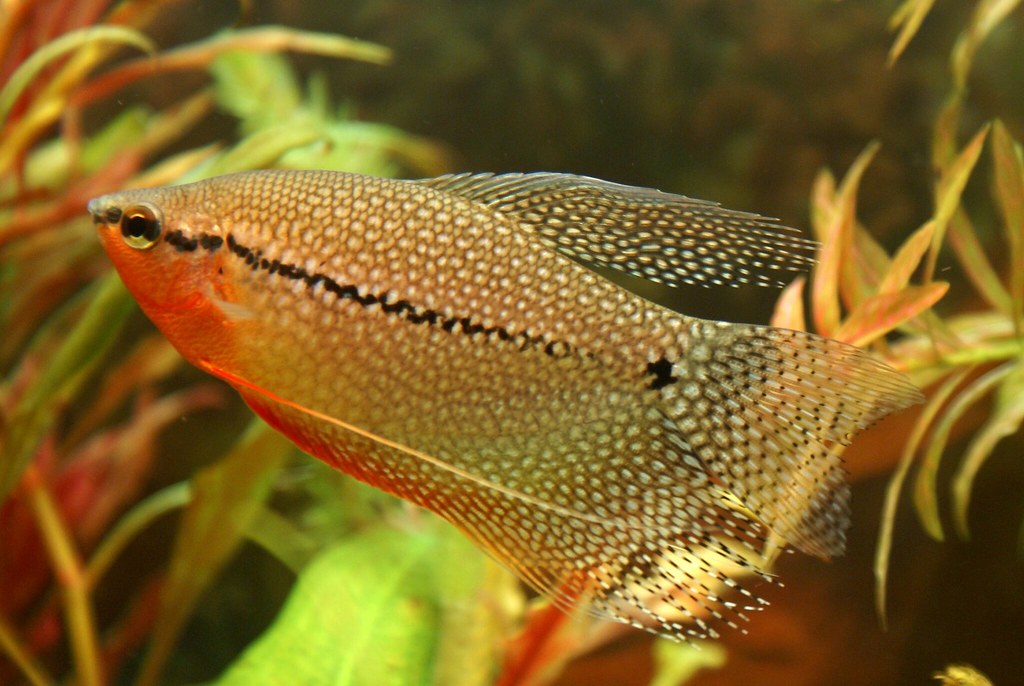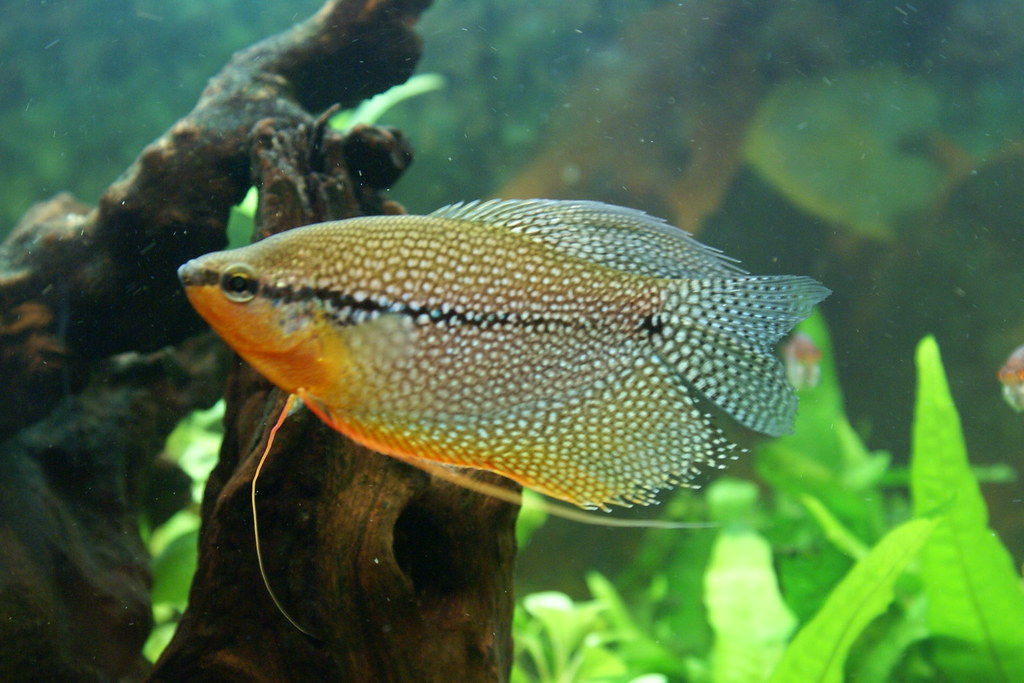Pearl Gourami
Highly prized for their visually appealing presence, Pearl Gouramis – Trichopodus leerii, also known as lace gouramis, are not only striking to behold but also notably simple to tend to within confinement. Whether kept individually, as a small unit, or amongst a variety of other species in a more community-styled habitat, Pearl Gouramis are a joy to keep for any aquarist.
- Experience Level: Beginner
- Hardiness: Hardy
- Minimum Tank Size: 30 gal (115 L)
- Maximum Size: 5 inches (13 cm)
- Temperament: Peaceful
- Temperature: 68 – 85° F (18 – 29.4° C)
- pH Range: 5.5 – 7.5
- Water Hardness: 5 – 19 dGH
- Diet: Omnivore
Table of Contents
Introduction
Size and Appearance
Care Guide
Tank Mates
Diet and Feeding
Breeding
These serene freshwater inhabitants go by many monikers. To some, they’re known as Lace Gourami, Diamond Gourami to others, and even labelled Mosaic Gourami in select local pet fish outlets. They’re uniquely beautiful occupants worthy of virtually any freshwater aquarium. Beyond prescribed care routines, understanding specific facts and statistics about the Pearl Gourami augments your overall care approach for these specimens.
These spotted beauties are endemic to the Indonesian Archipelago. You would typically find them in abundance within the swampy districts and river systems of Sumatra and Borneo.
Similar to its gourami relatives and certain betta species, Pearl Gouramis fall under the segment of Labyrinth fish. The term refers to their labyrinth organ, which facilitates their ability to siphon oxygen from the water surface.
Typically, adult Pearl Gouramis measure in the 4 to 5-inch range. However, younglings readily found in pet stores are closer to 2 or 3 inches, more likely the size you’d initially acquire.
Size and Appearance
The Pearl Gourami earns its name from the shining pearl-like spots adorning their bodies and extending onto their caudal, dorsal, and pectoral fins. These generate a captivating display as they glint within the tank.
Pearl Gouramis are identifiable not only for these pearl-like spots and their vibrant hues but also the distinctive black line extending from their heads to the junction of their bodies and caudal fin. It could be a challenge to spot this marking in darker-coloured Pearl Gouramis.
Renowned for their tranquillity, they are not overtly intrusive towards other fish, though male Pearl Gouramis are prone to become more combative and territorial during breeding seasons.
In terms of longevity, Pearl Gouramis fall short compared to hardier fish like loaches and some cichlids, with a lifespan averaging between 4 to 5 years.
Care Guide
- Minimum Tank Size: 20 gal (75 L)
- pH Range: 5.5 – 7.5
- Water Hardness: 5 – 19 dGH
- Temperature: 68 – 85° F (18 – 29.4° C)
- Lighting: Dim, diffused lighting
- Substrate: Dark sand/gravel
- Brackish: No
- Water Flow: Weak/Low
- Tank Region: All areas
Depending on your space and budget, Pearl Gouramis can comfortably inhabit exclusive, single-species tanks or larger, shared spaces. Regardless of your choice, understanding the required tank parameters is crucial in cultivating an ideal ecosystem for your Pearl Gouramis.
As beginners often debate over the appropriate tank size for their Pearl Gouramis, the rule of thumb is to procure the largest conceivable tank within reach.
More specifically, a Pearl Gourami-friendly tank should ideally hold a minimum of 30 gallons. This range comfortably accommodates a solitary Pearl Gourami. However, for those desiring a small Pearl Gourami school, an additional space allocation of between 10 to 15 gallons per fish is recommended, ensuring ample room for unhindered growth and movement.
A freshwater tank, densely populated with greenery akin to their indigenous habitat, simulates the most desirable conditions for Pearl Gouramis. A suggestion would be to incorporate live flora throughout the tank, creating an authentic Indonesian ecosystem for your new residents. Some options include the versatile Anacharis and Java Ferns, along with free-floating Hornwort. Hornwort, in particular, would significantly aid in bubble nest construction later.
Also, beneficial when setting up a Pearl Gourami tank is selecting dark sand, gravel, or a softer, grained substrate, akin to the conditions of their original riverbeds, lakes and swamps.
Pearl Gouramis favour slightly acidic conditions with a suggested pH level between 5.5 to 7.7. In terms of water hardness, similar to a selection of tropical fish, Pearl Gouramis are drawn to mildly hard to medium hard water sources. They are also credible adapters to hard water tanks. However, maintaining a tank hardness level between 5 to 15 dGH would better serve your fish.
Contrary to their natural habitat, Pearl Gouramis, as sturdy occupants, can withstand colder water temperatures. However, for optimal health and vitality, experts recommend warming the water. Consequently, ensure your tank water temperature falls within the 73 to 82 degrees Fahrenheit range to achieve Prime conditions for your Pearl Gouramis.
Often overlooked by novice aquarists is the light intensity within the tank, directly influencing the behaviour and activity levels of the inhabitants. Pearl Gouramis thrive in dimly lit environments. While floating plants aid in light regulation, a quieter, less illuminated corner within your home would serve as an excellent installation site.
Tank Mates
Pearl Gouramis project a general aura of peace. During breeding periods, the males can become more aggressive compared to females, but this scenario is easily curbed by pairing a single male with multiple females within an aquarium.
Observably, if a lone Pearl Gourami inhabits a larger shared tank, it tends to showcase more inhibited, fearful behaviour. Although feasible in single fish scenarios, they are more harmonic when kept in small groups, reducing tension and fostering a more jovial, relaxed environment.
In a community tank set-up, Lace Gouramis are relatively seamless to integrate, especially when forming a small group with one or two males and four or five females.
Here are the top three suitable tank mates for your Pearl Gouramis:
- Rasboras
- Corydoras Catfish
- Tetras
Feeding Guide
- Diet: Omnivore
- Frequency: Several small feedings per day
- Pellet Foods: Yes
- Flake Foods: Yes
- Live Foods: Yes
- Meat Foods: Yes
- Vegetable Foods: Yes, will often take partly cooked, dark leafy greens
As with all fish, their longevity is significantly influenced by their diet. Fortunately, feeding freshwater Pearl Gouramis is easy. As omnivores, they display no aversion to fish flakes or pellets and thrive on dietary variations.
• Live food such as blood worms, brine shrimp, and insect larvae.
• Fish Flakes, Pellets, and Frozen food.
• Leafy Vegetables providing additional nourishment. (Treat them occasionally with spinach or lettuce cuttings and blanched peas)
Breeding
Consistent with their overall traits, Pearl Gouramis are relatively uncomplicated to breed in home aquarium setups. However, successful breeding does require some forethought to ensure a higher likelihood of success.
Determining Pearl Gouramis Gender
A pre-requisite to initiating the breeding process is correctly identifying the gender of the Pearl Gouramis. Familiarising yourself with the physical disparity between the sexes is essential. Adults can be more accessible for gender identification due to their more pronounced physical traits.
Male Pearl Gouramis possess lengthier and sharper fins. Generally, they are less bulky and smaller than their female counterparts. During breeding times, males adorn a vivid, darker red colouration on their bellies and throats.
In contrast, female Pearl Gouramis are more rounded and voluptuous, most noticeable when spawning season nears. Their bodies assume a fuller formation in anticipation of releasing eggs for fertilisation. Unlike males, female Pearl Gouramis lack the striking red hue that adorns the males’ bellies and throats.
Setting the Stage for a Successful Breeding Period
Upon successful identification of male and female Pearl Gouramis, the planning for a fruitful breeding period can commence. Below are some expert-approved strategies to simplify Pearl Gourami breeding.
Choosing a Healthy Breeding Pair
The selection of a robust pair can largely influence the result of Pearl Gourami breeding. A compatible pair is usually displayed through noticeable attachment, reputable health status, and a striking appetite.
Considering a Standalone Breeding Tank
Although breeding Pearls in a community tank is plausible, a dedicated breeding tank is more beneficial for the breeding pair and you alike.
The likelihood of bubble nest construction, resulting in a more significant number of fertilised eggs, increases in a tank with only prospective breeding pairs. Ultimately, this ensures minimal stress on the hatching fry due to the absence of other fish and an unregulated environment.
Maintain soft and mildly acidic water within the breeding tank, keeping it warmer than the main tank (about 80 degrees Fahrenheit). Include rooted and floating plants in the tank as cues for your Pearl Gouramis to initiate bubble nest construction.
Ensuring Pearl Gourami Fry Prosper
Remove the female immediately after egg deposition within the bubble nest to prevent egg consumption. It also helps reduce unnecessary male chase within the tank. The eggs generally hatch within 24 to 48 hours, with the male Pearl Gourami devotedly caring for the eggs until this process completes. The fry typically remain close to the bubble nest for about three to five days; by then, they are capable of independence.
Maintaining a clean tank and providing the Pearl Gourami fry with baby brine shrimp supports growth. Owing to their rapid growth rate, transfer Pearl Gouramis to the community tank once they attain an approximate length of one inch.



